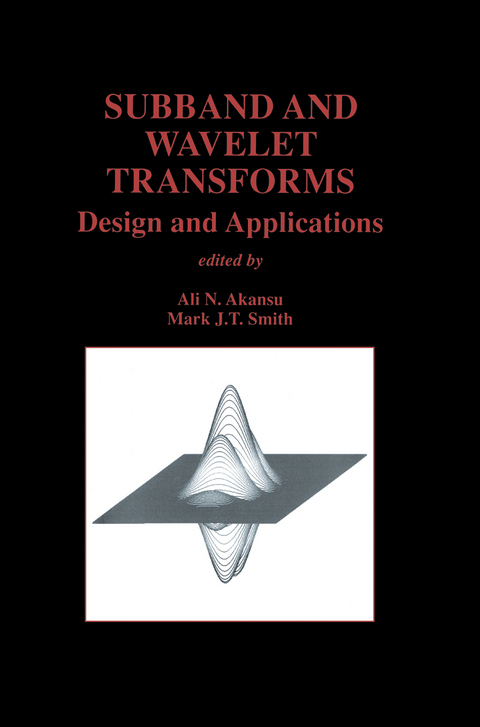
Subband and Wavelet Transforms
Springer-Verlag New York Inc.
978-1-4612-7580-0 (ISBN)
1 Introduction and Overview.- 1 Introduction.- 2 Filter Banks and Transforms.- 3 Analysis/Synthesis Filter Banks.- 4 Two-Band Filter Banks.- 5 Tree-Structured Filter Banks.- 6 M-Band Filter Banks.- 7 Multidimensional Filter Banks.- 8 Wavelet Transforms.- 9 Historical Overview.- 2 Fundamentals and Optimal Design of Subband and Wavelet Transforms.- 1 Introduction.- 2 Fundamentals.- 3 Polyphase Decomposition.- 4 Uniform M-Band Filter Banks.- 5 The Two-Band Case and Tree Extensions.- 6 The Wavelet Transform and Dyadic Filter Banks.- 7 Time-Frequency Localization.- 8 Optimal Design and Performance.- 9 Progressive Optimality in Subband Trees and Wavelets.- 10 Discussions and Future Research.- 3 Matrix Theory for Filter Bank Analysis and Design.- 1 Introduction.- 2 Transform Domain Formulations.- 3 Time-Domain Formulation.- 4 Filter Bank Design Using the Time Domain Equations.- 4 IIR Filter Banks and Wavelets.- 1 Introduction.- 2 IIR Polyphase Networks.- 3 Two-Channel IIR Filter Banks and Wavelets.- 4 IIR Filter Design and Implementation of Two-Channel Filter Banks.- 5 M-Channel IIR Filter Banks.- 6 IIR Filter Design for M-Channel Filter Bank.- 7 2-D IIR Filter Banks.- 8 Concluding Remarks.- 5 The Continuous Wavelet Transform, from 1 to 3 Dimensions.- 1 Motivation.- 2 The Main Features of the 1-D CWT.- 3 Mathematical Analysis of the 1-D CWT.- 4 Discretization of the 1-D CWT.- 5 Implementation of the 1-D CWT.- 6 The CWT in Two Dimensions.- 7 Going to Higher Dimensions.- 8 Outcome.- 6 Time-Frequency Localization with Non-Stationary Wavelet Packets.- 1 Introduction.- 2 Non-Stationary Wavelet Packets.- 3 Frequency Localization and L1 Fourier Estimates.- 4 Estimates on the Variance of ?n.- 5 Conclusion.- 7 Subband Image Coding.- 1 Theoretical Foundations of Subband Image Coding.-2 Image Subband Decomposition.- 3 Compression of Image Subband Signals.- 4 Conclusions.- 8 Subband Video Coding.- 1 Introduction.- 2 Basic Forms of Subband Video Coding.- 3 Spatially Scalable Intraframe Subband Coding.- 4 Spatially Scalable Motion-Compensated Interframe Subband Coding.- 5 Spatio-Temporally Scalable 3-D Subband Coding.- 9 Audio Coding with Filter Banks.- 1 Introduction.- 2 The Human Auditory System.- 3 The Auditory Filter Bank.- 4 The Audio Signal.- 5 Interactions Between Auditory Filter Bank and the Audio Signal.- 6 Conclusions.- 10 Wavelets and Filter Banks in Spread Spectrum Communication Systems.- 1 Introduction and Background.- 2 Transform Domain Processing Using Wavelets and Filter Banks.- 3 Data Modulation Using Filter Banks.- 4 Conclusions.- 11 Acoustic Echo Cancellation Using Subband Adaptive Filtering.- 1 Introduction.- 2 Linear FIR Adaptive Filtering.- 3 The Subband Adaptive Filtering System.- 4 Computational Complexity of the Subband Adaptive Filtering System.- 5 Experimental Setup.- 6 Critically Sampled Systems.- 7 Oversampled Systems.- 8 Conclusion.- 12 Analog Scramblers.- 1 Introduction.- 2 Four Techniques for Analog Scrambling.- 3 Filter Bank Analysis for Analog Scramblers.- 4 Conclusions.- 13 Multitone Modulation.- 1 Introduction.- 2 Information Theory.- 3 The QAM Multitone Modulation.- 4 The Twisted-Pair Channel.- 5 Decision Feedback Equalization Comparison.- 6 Discrete Multitone (DMT)—An Implementation.- 7 Summary and the Future.
| Reihe/Serie | The Springer International Series in Engineering and Computer Science ; 340 |
|---|---|
| Zusatzinfo | XVIII, 452 p. |
| Verlagsort | New York, NY |
| Sprache | englisch |
| Maße | 155 x 235 mm |
| Themenwelt | Informatik ► Grafik / Design ► Digitale Bildverarbeitung |
| Informatik ► Theorie / Studium ► Künstliche Intelligenz / Robotik | |
| Mathematik / Informatik ► Mathematik ► Algebra | |
| Mathematik / Informatik ► Mathematik ► Angewandte Mathematik | |
| Technik ► Elektrotechnik / Energietechnik | |
| Technik ► Nachrichtentechnik | |
| ISBN-10 | 1-4612-7580-6 / 1461275806 |
| ISBN-13 | 978-1-4612-7580-0 / 9781461275800 |
| Zustand | Neuware |
| Informationen gemäß Produktsicherheitsverordnung (GPSR) | |
| Haben Sie eine Frage zum Produkt? |
aus dem Bereich


